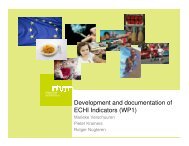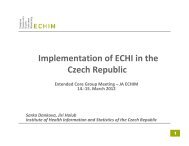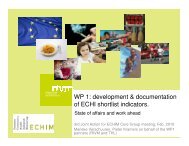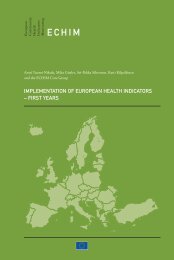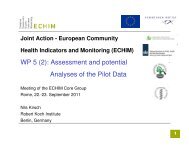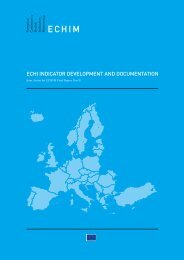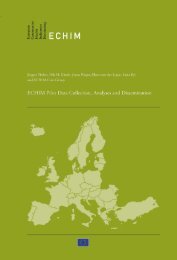INDICATORS
ECHIM Final Report
ECHIM Final Report
Create successful ePaper yourself
Turn your PDF publications into a flip-book with our unique Google optimized e-Paper software.
Antti Tuomi-Nikula, Ari-Pekka Sihvonen, Jürgen Thelen<br />
5. IMPLEMENTATION OF ECHI <strong>INDICATORS</strong><br />
5.1. The implementation process and tools<br />
The first step in the process of implementing the ECHI indicators was to assess the<br />
current situation in EU Member States with regard to indicators and data. This<br />
involved, first, collecting and summarising the evidence already provided by all the<br />
main international sources of information such as Eurostat, the WHO, the OECD<br />
and the previous EU project reports prepared under the DG SANCO Public Health<br />
Programme. The results of this exercise were summarised in the Country Reports, which<br />
outline the availability of health indicator data by country in international databases, as<br />
described in Chapter 4.<br />
The second step in the implementation process was to deepen the information gathered<br />
in the Country Reports by a survey covering all EU Member States, Candidate Countries<br />
and EFTA/EEA countries. It was deemed necessary to gather further information in<br />
order to be able to assess which additional health data and indicators not found in the<br />
international databases are available in each country at the moment and in the near<br />
future, from which sources the health information is derived, and to gain an overview<br />
of the health information and health reporting systems in each of the participating<br />
countries. This was done by the ECHIM Survey.<br />
The specific topics dealt with in the ECHIM Survey were the availability of data for the<br />
ECHI shortlist indicators with regional subdivisions and other breakdowns as well as<br />
time series, possible new data sources and their accessibility and quality, organisations<br />
gathering data and institutes producing health statistics, further details of health<br />
information and health reporting systems, and future expectations. The respondents<br />
were also asked about their initial ideas of how to promote implementation of the ECHI<br />
indicator system in their countries.<br />
The ECHIM Survey was addressed to the ECHIM contact persons in all 32<br />
participating countries. The contact persons are public health specialists who mainly<br />
work for the responsible national authorities, usually public health authorities, regional<br />
public health authorities and statistical offices, and Ministries of Health. The contact<br />
persons were expected to reply to the survey based on their own understanding of the<br />
56



